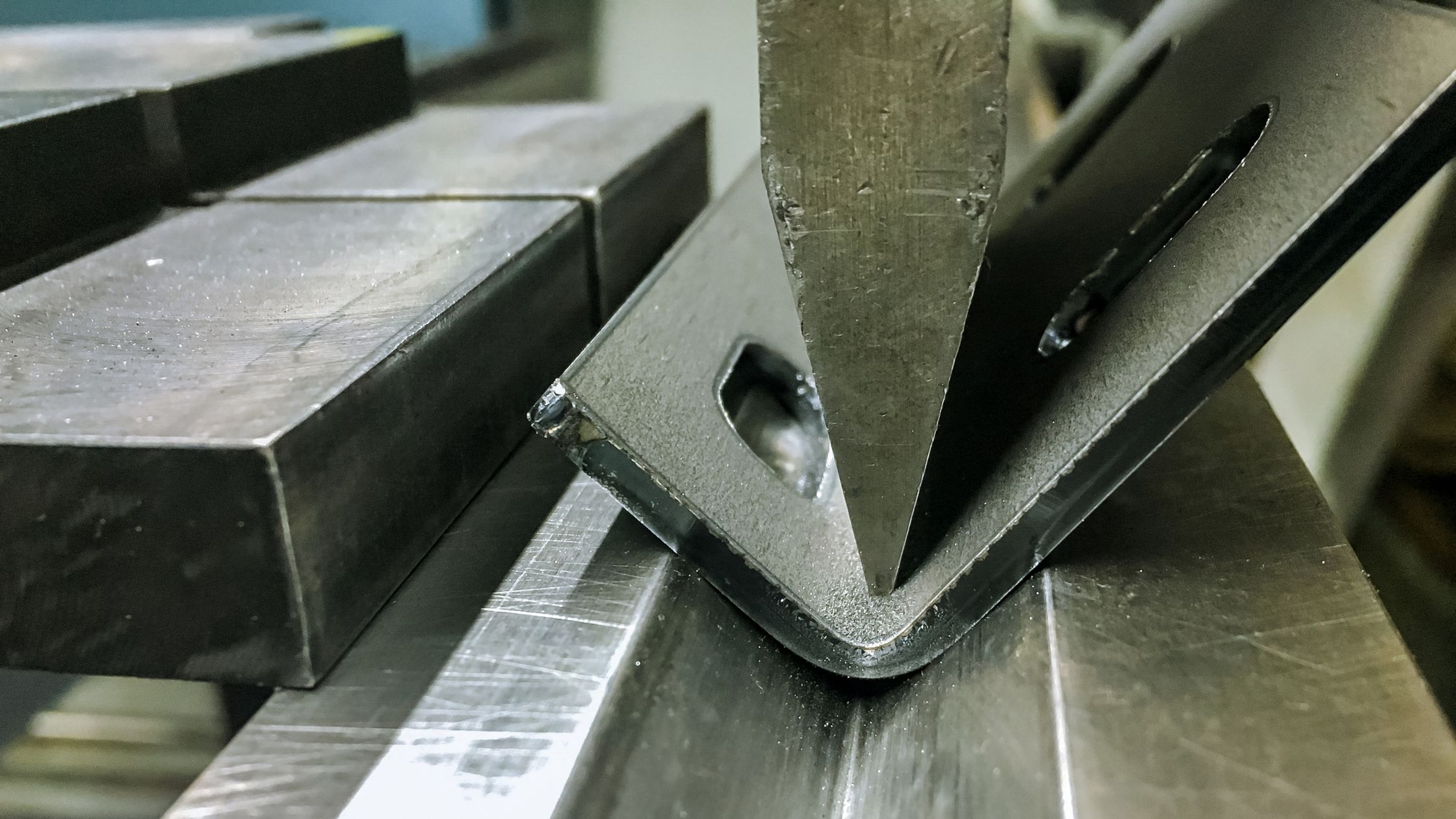Bending sheet metal is a popular technique to create parts for many industries, from automotive to aerospace. But giving various types of metals different shapes through bending is not always a straightforward process. Does heating before bending sheet metal make the procedure easier?
Preheating metal is one way of sheet metal bending. When heated, metals become more malleable and easier to transform into new forms without cracking or kinking. Applying heat on targeted areas allows the metal to be shaped precisely according to design specifications.
We’ll discuss all the basics of heating before prototype or custom sheet metal bending. You’ll learn the methods of heating sheet metal and why and when to use them.
What is Bending Sheet Metal?
Sheet metal bending is a process of shaping thin pieces of metal into various forms, like various angles and curves. This can be done using different methods, including applying heat or using machines.
There are specific rules and measurements to consider during the bending process. For instance, you need to pay attention to the material being used and calculate the k-factor (ratio of the sheet’s thickness to the neutral axis), which helps predict how the metal will behave during bending. This ensures that the final shape meets design requirements.
The bending of sheet metal goes by several names, like forming, folding, or flanging. Each term might refer to slightly different techniques or tools used for the bending process. For example, press braking involves a machine that applies pressure to bend the metal accurately.
Sheet metal parts made with bending are found in many fields, including construction, automotive design, and even in aerospace. It helps create important fixtures, like flanges and indents, that add strength and functionality to metal structures.
Do You Heat Metal Before Bending?
Some metals are tough and can crack if you try to bend them cold. But applying heat can make the job easier, as it makes the metal softer and easier to shape. Techniques like hot forming and annealing are essential for this process because they help you bend metal without breaking it.
Curious about how to use these methods effectively? Let’s find out:
1. Hot Forming Aluminum
If you want to bend metal sheet made of harder aluminum alloys, like those above 5054, you need to apply heat along the bend line. Without using heat, the metal can crack when you apply force to bend it.
Aluminum melts at a lower temperature than steel, between 865 and 1,240 degrees Fahrenheit. Because of this, you must be careful not to overheat it. When you heat aluminum, it becomes easier to shape, but it also has a tendency to spring back after bending. It means that even if you achieve the right angle initially, the metal might slightly return to its original shape as it cools.
You should keep watch on the entire heating process very closely. Unlike steel, which changes color as it heats, aluminum might not give you the same visual cues. You can use an oxyacetylene torch to heat it, looking for a golden hue. Be mindful of the heating process because too much heat can make aluminum brittle or even melt it completely.
2. Hot Forming Steel
Hot forming steel involves heating steel sheets to a much higher temperature, typically between 1,600 and 1,700 degrees Fahrenheit. This high heat allows the steel to become more malleable, which is great for bending. At these temperatures, the molecular structure of the steel changes, which helps prevent issues like strain hardening and cracking.
One major advantage of hot forming steel is its increased formability, which makes it easier to shape than cold forming. If a press brake struggles to bend a cold plate, it may handle the same plate much better when heated.
However, hot forming isn’t without its challenges. The high temperatures can lead to oxidation, which can harm the surface quality of the steel. There’s also the risk of decarburization, where the carbon content in the steel decreases. This can weaken the metal and lead to problems later on, so it’s important to test the material after hot forming to ensure it meets the required standards.
3. Annealing Sheet Metal
Annealing is another effective method to prepare metal for bending. The process involves heating the metal to a specific temperature to reduce its hardness. By doing this, the metal becomes more ductile and less likely to crack during bending.
During annealing, the metal is heated in a controlled environment, often in a furnace. Once it reaches the desired temperature, it cools slowly. This gradual cooling is important because it helps create a uniform grain structure, which leads to smoother bends.
In addition to making bending easier, annealing also improves the metal’s ability to be shaped and cut. So, annealing could be more effective than hot forming in producing better products when you’re working with aluminum or steel.
Why Heat Metal Before Bending
While many thin sheets can bend without heating, some situations call for preheating. Let’s explore why heating before bending sheet metal is necessary in some cases:
a. Reducing Localized Stress
Bending metal can create localized stress, especially at the bend points. When you apply force to bend metal, some areas experience more stress than others, which can cause the material to crack or break.
Heating the metal helps reduce this stress. By warming it up, the metal becomes more flexible, allowing it to bend without breaking. It’s especially important for thicker metals, where the risk of stress concentration is higher.
b. Improving Material Flow
Heating metal before bending improves its ability to flow. When the metal is warm, its particles are more active. This increased movement allows the metal to change shape more easily. It helps prevent the formation of sharp edges or folds that can occur when bending cold metal. As the particles flow into the desired shape, the metal sheet maintains its integrity, resulting in a cleaner bend.
c. Enhancing Ductility
Ductility refers to how easily a material can deform without breaking. Most metals become more ductile when heated. For example, when you heat aluminum or steel, they can stretch and bend much more than when they’re cold. This is vital for achieving tight bend radii without risk of fracture. A higher ductility means you can create more complex shapes and designs without worrying about damaging the metal.
d. Easy Bending of Thicker Materials
Thicker materials are less forgiving than thin sheets. If you try to bend them cold, especially those over 0.75 inches, you might face severe cracking or warping. Preheating these materials allows them to bend more easily, making the process smoother and more manageable. It also helps ensure that the final product meets quality standards.
e. Managing Residual Stress
Residual stress can linger in metal after cutting or shaping. This hidden tension can lead to unexpected deformations during bending. Heating the metal can help alleviate these stresses.
Techniques like annealing, which involves heating and then slowly cooling the metal, allow the internal structures to rearrange. It helps to create a more stable material before bending, reducing the chances of issues arising during the actual bending process.
f. Facilitating Crystal Structure Adjustment
Metal is made up of a crystalline structure that can become distorted when bent. Heating the metal adds energy to these crystals, allowing them to move more freely.
When the metal is warm, dislocations within the crystal lattice can glide more easily. This makes it simpler for the metal to bend without breaking. Once the metal cools down after bending, the crystals realign themselves, restoring the material’s strength without the previous distortions.
When to Heat Metal Before Bending
We’ve already discussed two methods, hot forming and annealing, for heating metal sheets before bending. But when should you apply the heat for an easier bending process? Let’s find out:
When to Use Hot Forming
Hot forming is a technique that can make bending metal easier and more effective. But when should you choose this method? Let’s discuss some key situations where hot forming shines:
Working with Fragile Materials: If you have fragile or high-tensile materials, hot forming is often the way to go. These materials can crack or break under stress. By heating them, you make them more pliable. This reduces the risk of damage during the bending process.
Large Metal Sheets: Larger bars, like thick steel beams, require more force to bend. When you heat the metal, it becomes easier to manipulate. This means you can use lighter equipment, saving time and resources. If you’re dealing with large pieces, hot forming can simplify your work.
Galvanizing the Metal Surface: Another important factor is whether the metal will undergo surface treatments, like hot dip galvanizing. This process can create challenges if the metal has been cold bent. Cold bending can lead to hydrogen embrittlement, which makes the metal more likely to crack. Heating the metal before bending helps avoid this issue, ensuring a stronger final product.
Bend Radius and Material Grade: The bend radius is also vital in deciding whether to use hot forming. Different grades of steel have varying flexibility. A tighter bend might need hot forming, especially with tougher materials. This ensures that the metal can handle the shape without breaking.
When to Use Annealing
Annealing is a helpful process in metalworking, especially before bending. Knowing when to use it can make a big difference in your project. Let’s find out the best times to consider annealing:
Reverse Metal Hardening: When you bend metal, it can become harder due to something called work hardening. This happens because the metal’s structure changes during the bending process. If the metal gets too hard, it can crack or break. If this happens, you can use annealing to restore the metal’s softness.
Difficult-to-Shape Metals: If you’re working with aluminum or copper and find it difficult to shape, heating it can help. Annealing makes the metal more ductile, allowing for easier manipulation without damage. It also relieves any internal stresses that might have built up during previous work.
Handling Complex Shapes and Designs: If you’re creating complex parts, annealing becomes even more important. For intricate designs, the metal must bend and twist without cracking. Annealing ensures that the material can handle these changes.
Conclusion
So, is heating before bending sheet metal necessary? It actually depends. Sometimes, heating can make the process easier and help prevent cracks. But other times, it might not be necessary. It all depends on the type of metal, its thickness, and the shape you want to create. Having a clear idea of when and how to apply heat is important for simplifying the process and achieving accurate shapes.
Zintilon could be your trusted partner for supplying all kinds of sheet metal fabrication, bending, and other services. We specialize in custom machining, from sheet metal manufacturing to CNC milling and more. Contact us for a free quote and let our experts handle your metal part needs.





